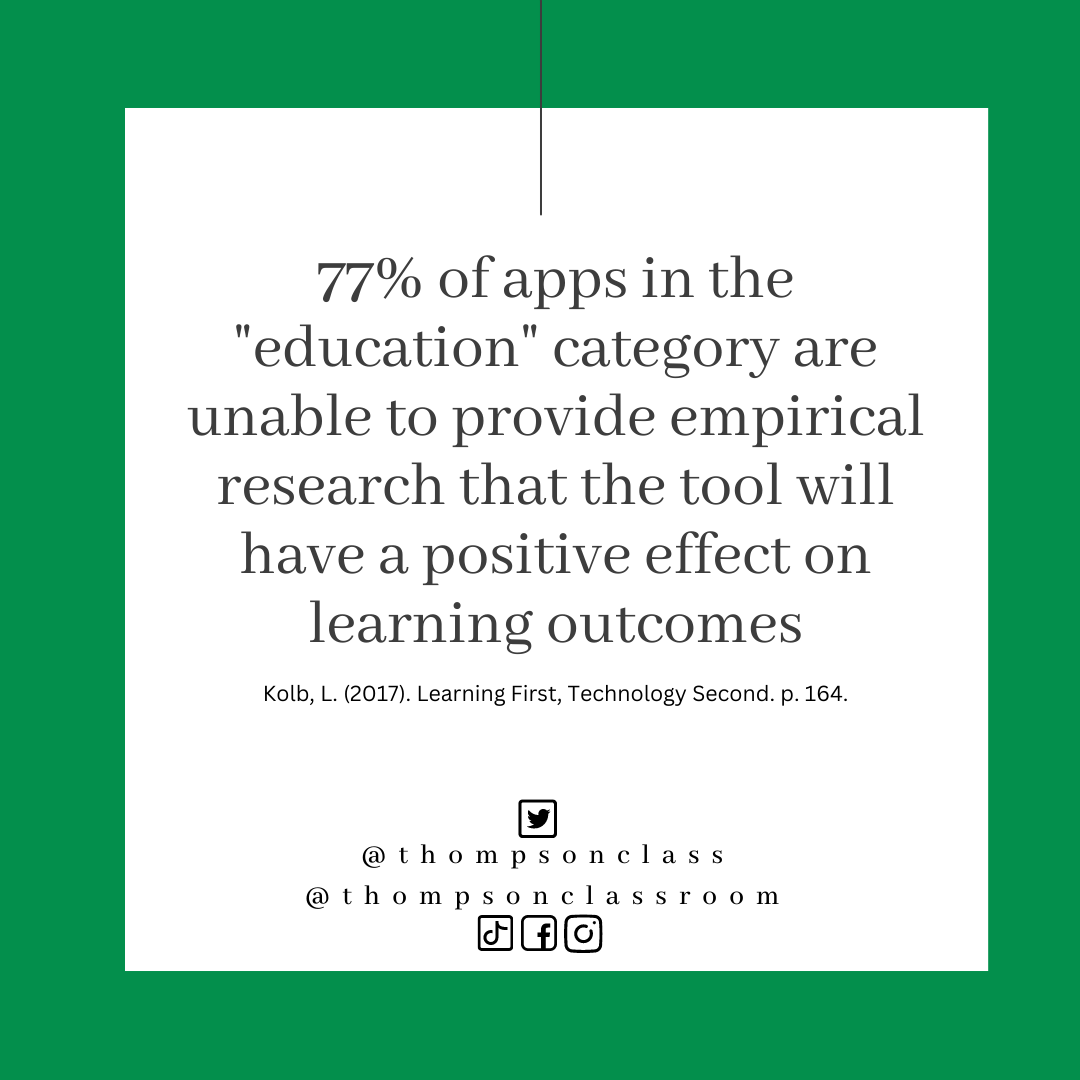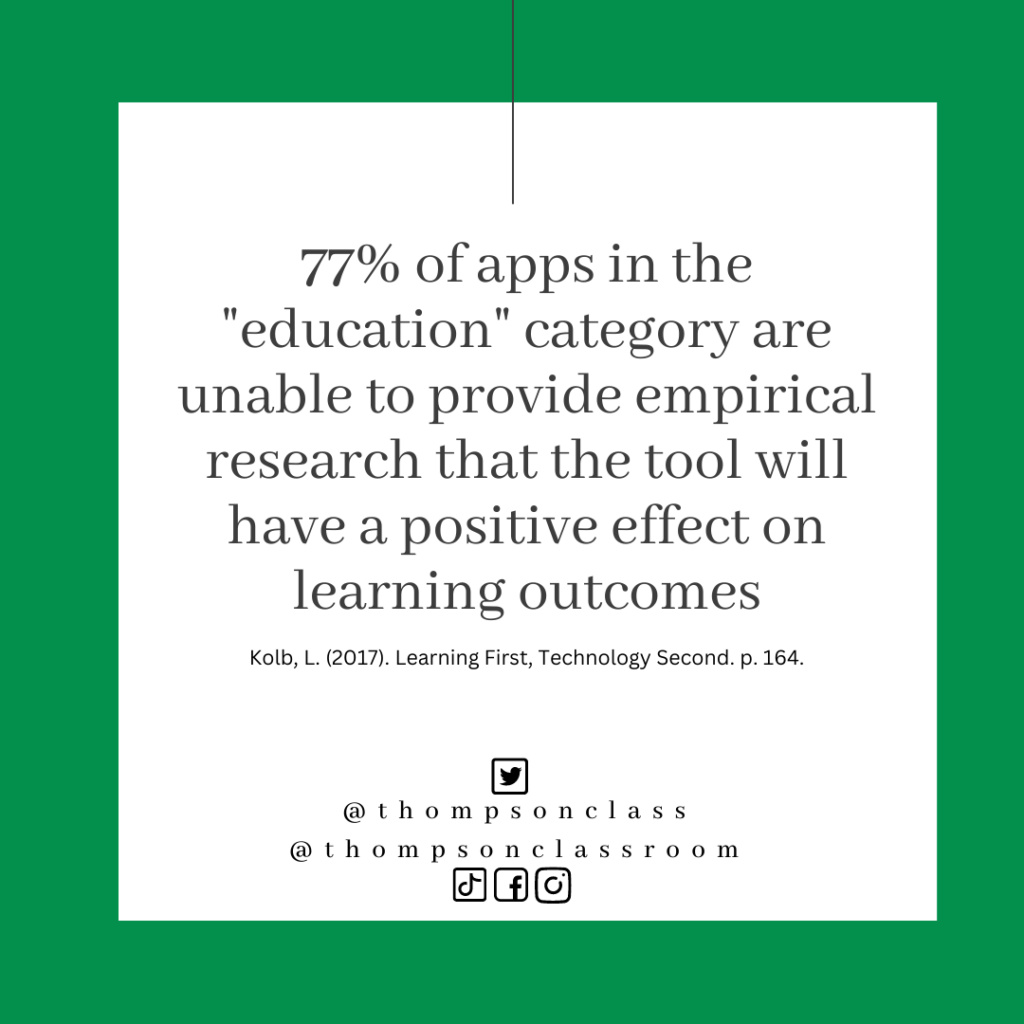Educational Apps – Challenges

Every Monday I share a different ed tech quote on our Thompson Classroom social media pages for our staff to consider.

One unseen benefit of the Covid-19 pandemic is that the use of technology in education has increased at a far higher rate than if our traditional classroom model was still in place (Nantais, M. et al., 2021, p. 34). The switch to remote learning has placed all educators, students, and families in a position where they are required to modify their existing practices and learn how to use digital tools in new ways. However, an increase in the use of online tools has not always been accompanied by a switch in pedagogical practices; especially for educators who are teaching face-to-face and remote students simultaneously (Nantais, M. et al., 2021, p. 34). I argue that teaching online using face-to-face strategies can be equated to listening to the audio of a television show versus a podcast or audiobook. While the basic idea of the story is still communicated, there are many details that are lost without access to the visual elements scripted into the show. A podcast or audiobook, however, accounts for this medium and plans their descriptions and use of sound effects to provide a clear picture for the audience. As I support our local stakeholders in their use of technology it is imperative that their familiarity and navigation of digital tools is paired with an understanding of what makes for a high-quality resource and what strategies need to accompany it’s use that are appropriate for the age and stage of the children they work with. My thesis will be used to develop a tool for educators to use in the evaluation of apps/software before implementation in the classroom.
Educators are ill-equipped to analyze educational software to determine suitability for their programming. The Covid-19 pandemic, and its resulting influence on educational programming, has accelerated the rate at which educators integrate digital tools into their programming (Nantais, M. et al., 2021, p. 34) but Latchem (2013, p. 384) warns that, “educators need to resist the urge to jump at new ideas without thinking of how its implementation can be maximized, what problems may arise, and how sustainable the tool will be for students down the road”. Johnson, Riel, and Froese-Germain (2016, p. 43.) found that 45% of surveyed Canadian educators felt that they lacked sufficient support when it came to learning how to use networked technologies in their teaching practice. Survey results also communicated that 22% of teachers felt ill-prepared to, “teach students how to use networked technologies to support their learning” (2016, p. 61). While Johnson, Riel, and Frose-Germain argued in 2016 that there, “needs to be support for teachers to apply their professional autonomy and judgement to determine, from a pedagogical perspective, the best use of new technologies to support learning” (p. 78) data from 2021 indicates that teachers continue to lack confidence in the area of educational technology and look to technology leaders to assist in the evaluation of software suitability (Nantais, M. et al., 2021, 34-35).
There are currently several well-known technology integration models with T-PACK, SAMR, and LoTI being among the most recognized (Arora & Chander, 2020, p. 84). However, these models each operate under the assumption that participating educators are comfortable with selecting suitable software to implement and fail to address why integration may be unsuccessful based on ill-suited software selections. For educators who do not feel confident in their personal evaluation of educational software their options include: 1. asking for support from technology leaders, 2. accessing crowd-sourced reviews online, 3. utilizing third-party review platforms, or 4. trial and error with their students. None of these methods empower educators in their ability to make an informed decision independently. Kolb (2017, p. 164) emphasizes that 77% of mobile apps included in the “education” category are unable to provide, “empirical research that the tool will have a positive effect on learning outcomes”. Furthermore, these options run the risk of long turn-around times if technology leaders are not immediately available and ill-informed suggestions if reviews are not conducted by those with backgrounds in effective digital pedagogies. The Triple E Framework by Kolb (2017, p. 5) builds on the integration methods previously mentioned but also strives to assist educators in their evaluation of digital tools. While the Triple E Framework is a start, there continues to be gaps in the areas of accessibility [language choices, speech-to-text, text-to-speech, visual stimulation, fine motor requirements] and consumerism [initial and ongoing costs, ad exposure, data usage]. Further research into this area can assist in achieving social emancipation for educators who previously relied on third-party platforms or specialized staff to make programming recommendations outside of the contextual classroom understanding of the individual educator.
Johnson, M., Riel, R., & Froese-Germain, B. (2016). Connected to learn: Teachers’ experiences with networked technologies in the classroom. Ottawa, ON: MediaSmarts. Retrieved f rom http://mediasmarts.ca/sites/mediasmarts/files/publication-
report/full/ycwwiii_connected_to_learn.pdf
Kolb, L. (2017). Learning first, technology second: The educator’s guide to designing authentic lessons. Internation Society for Technology in Education.
Latchem, C. (2013). Whatever became of educational technology? The implications for teacher education. World Journal of Educational Technology, 5(3), 371-388. Retrieved from http://www.world-education-center.org/index.php/wjet/article/view/2873/pdf_219
Nantais, M., Dimuro, M., Kelly, W., Kirk, J., Lam, M., Ofwono, N., & Spence, S. (2021). Digital policy, infrastructure, procedures and practices of select rural and northern Manitoba school divisions. BU CARES. https://www.brandonu.ca/bu-cares/files/2021/08/Digital- Realities-in-Rural-Manitoba-July-2021.pdf